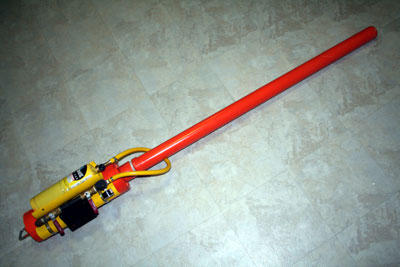|
Mom always said, "Don't play with your food." Well, we have a better idea...
HogTek 9000 pics coming soon... I met my first potato cannon in a meadow beside the Connecticut River in New Hampshire. It was a cheesy one, as spud guns go nowadays, but we spent hours upon hours spraying Aquanet and blasting any vegetable within reach across the river. And I was forever hooked. Ever since then I've been tinkering with the HogTek spud guns. FIRST THINGS FIRST... The HogTek Spudchuckers use a high-energy explosion to propel a projectile at lethal velocities. It is not a toy for children of any age. The HogTek SpudChucker pages are provided as an illustration of the author's experimental foray into the world of vegetable acceleration. I did it at my own risk and anyone else who decides to build their own SpudChucker or variant does so at their own risk as well. Hello people... shit explodes inside these cannons and a 200 caliber projectile comes out the end really fast! Unless you are absolutely sure that you have the plumbing, electrical and mechanical skills to accomplish the task safely then DON'T DO IT! What's On These Pages? There are a bunch of things that you need to know before you undertake a spud gun project. These mostly involve safety and required skills and I'll be as comprehensive as I can... but that ain't any sort of guarantee. Here goes... Plumbing: You must understand basic PVC welding (gluing) techniques. This includes the cutting, fitting and welding of PVC pipe and fittings. If you do not, you could die. Use a quality PVC glue and make sure that you clean and treat all connections according to the glue manufacturer's instructions. If you do not, you could die. When cutting the PVC, the cuts must be square. Use a miter box on all cuts. If you screw up a cut you must throw the piece away and start over. If you do not, you could die. If you screw up a connection while welding the plumbing components you MUST throw away the assembly and start over. Yes, it is expensive to do this but PVC connections cannot be fixed after they've set for as little as a few seconds. All connections must be fully seated inside the fitting. If they are not, the cannon could blow apart and you could die. All connections between metal pipe components must be sealed with a gas-rated Teflon tape or equivalent to seal the connections. Regular Teflon tape will degrade in the presence of the MAPP gas and could cause MAPP gas to leak outside the cannon. If ignited, the leaked gas could badly burn you. Anything that protrudes into the combustion chamber needs to be threaded tightly into the PVC itself, and only at points where the PVC is double thick (through the fitting as well as the pipe). Use a thread tap, or take special care to thread tightly without over-stressing the PVC itself. If any connection is loose it will become a secondary projectile and you could get hit and die. If the PVC is over-stressed, it could rupture and you could die. Electrical: For more complex cannons that use electronic ignition systems and chamber fans, both mechanical fasteners as well as soldered joints are used. You should know how to solder a connection. You should know how to test the functionality of switches. You should know how to insulate various standard and non-standard connections. Be sure to thoroughly test the entire electrical ignition system before test firing. Mis-wiring a switch or leaving connections uninsulated can cause the cannon to fire unexpectedly and you could die. Mechanical: You have to know how to use basic tools like a wrench and pliers and a screwdriver. If you do not, you are probably already dead. Other power tools that help greatly are a belt sander, a power miter box (although a manual miter box works fine too), and a table saw. General: Never point the assembled cannon at anything that you don't want to slam a potato into... or through. Potatoes can kill. Per the ATF spud guns are legal and do not require a permit to build or transport. But use common sense here... don't go shooting from the car window or crippling the neighbor's dog! So, I hope by now you get the fact that if you fuck this up you could kill yourself or someone else. Use good judgement. Borrow somebody's if you don't have any. If you have to question something then consider it no good and find another way or don't do it at all. And by the way... don't bring one of these to the airport... OK, you've been warned. Here's the menu: Using the Menu: Under Spudding Info you'll find general spudding info (duh), safety stuff, and other bits and pieces that make this hobby a little bit easier and fun. Under Spud Gun Systems you'll find all the theory and design information for each of the five systems in a potato cannon. This is all the math and underlying methodology that you'll need to understand what's going on in these things. If you understand the info here you'll be able to design your own cannon models. Under HogTek Builds you'll find the specific plans and construction instructions for building each of the HogTek cannons. There's no theory here, just the build instructions.
|
|||||||

